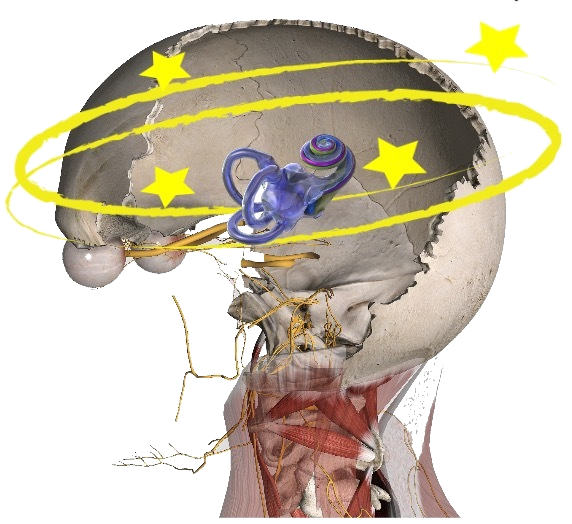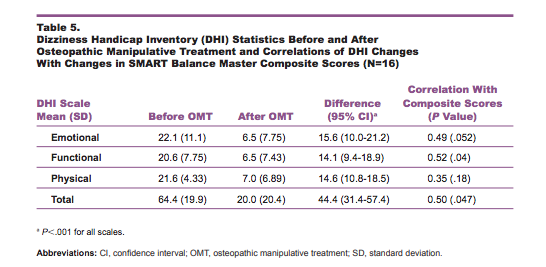
While answering the question, “Is Osteopathic Treatment effective on Cervicogenic Dizziness”, I must preface to say I am not an osteopathic physician and do not practice in that theoretical construct. However, for those readers who understand the mechanisms of manual therapy and history behind the field of Physical Therapy and Osteopathic medicine; I am sure you can appreciate the correlation of Osteopathic medicine and subset of Manual Therapy within the larger scope of practice in Physical Therapy. Here is a synopsis if you haven’t delved into the history. Understanding this correlation will allow the clinician to delve deeper into the literature of other professions in order to have a broader consideration of the effects of manual therapies on individuals suffering from Cervicogenic Dizziness and ultimately give your patients the most comprehensive treatment.
While inquiring PubMed for literature support, unfortunately the terminology of Cervicogenic Dizziness comes up empty. Why? Well, read a previous post for that. Nonetheless, Cervical Vertigo brings me information from Hulse et al in 1975. As expected, the thought process realms from disturbances of the upper cervical spine and the authors recommend manipulation as treatment of choice.
As the years go by, it is difficult to find literary works specifically for the benefit of Osteopathic treatment for Cervicogenic Dizziness. However, we do have a some information provided by:
- A case report by Kennedy in 2002
- A case report by Shaffer in 2005
- A case report by Fraix in 2009.
- A case series by Berkowitz in 2009.
- A case report by McCallister et al 2016 – of note, this was on a patient with severe TBI
Since these are in the lower levels of evidence, the main chunk of justification doesn’t start until when we delve into Fraix’s work in 2010. A pilot study, here is Fraix’s conclusion
This study showed that OMT is generally well tolerated in patients with vertigo. It also demonstrated that it is feasible to recruit a population of patients with vertigo who can complete a course of OMT and collect data by using the DHI. A randomized control trial that examines the efficacy of OMT in patients with vertigo is warranted, given that OMT may be a reasonable treatment for vertigo and the functional impairment associated with it.
Of course this study has limitations, but I do like how it uses the Dizziness Handicap Inventory (DHI) as a functional outcome measure to show effectiveness of the intervention with a validated and reliable outcome measure. See results in Figure 1 from the article below:

As far as I know, a follow-up RCT designed to compare Osteopathic Treatment to Vestibular Rehabilitation never made it to publication. However, we do have some other evidence of the effects of osteopathic treatment in the last few years.
In 2013, Fraix and colleagues in a prospective clinical cohort study evaluated the effect of osteopathic manipulative treatment (OMT) for spinal somatic dysfunction in patients with dizziness lasting longer than 3 months. Here is their conclusion:
Osteopathic manipulative treatment for spinal somatic dysfunction improved balance in patients with dizziness lasting at least 3 months.

In 2017, Papa and colleagues in a randomized control trial examined a group of 31 individuals with BPPV and again used DHI as outcome measure. Here is their conclusion:
These findings suggest that OMT could be a useful approach to reduce imbalance symptoms and to improve the quality of life in patients suffering from dizziness

In conclusion, the evidence is slowly, but starting to mount to give more credence to Osteopathic Treatment for Cervicogenic Dizziness. I do not hesitantly justify this as simply another means of evidence denoting the benefit of manual therapy, which can be provided by trained physical therapists, for the treatment of Cervicogenic Dizziness / Cervical Vertigo.
The justification for our services and approaches are continuing to mount, for the sake of the patient, our referral sources, for us personally and for the 3rd party payers. Anyone who has taken my courses knows evidence is a top priority and you will get the information you need to not only learn how to diagnose and treat Cervicogenic Dizziness, but the paper trail that puts more substance into our practice.
You can learn more about the screening and treatment process of Cervicogenic Dizzinesss through Integrative Clinical Concepts, where the authors (husband–a manual therapist a wife—a vestibular specialist), teach a very unique course combining both the theory and practice of vestibular and manual principles in their 2-day course. Pertinent to this blog post, the 2nd day includes the “Physio Blend”, a multi-faceted physiotherapist approach to the management of Cervicogenic Dizziness, which includes treatments of the articular and non-articular system of manual therapy and the most updated sensorimotor exercise regimen.
If you would like to host a course for your staff (either a vestibular, neuro, sports or ortho clinic), please do not hesitate to contact me at harrisonvaughanpt@gmail.com for more information.
Authors
Harrison N. Vaughan, PT, DPT, OCS, Dip. Osteopracic, FAAOMPT
Instructor: Cervicogenic Dizziness for Integrative Clinical Concepts
Danielle N. Vaughan, PT, DPT, Vestibular Specialist
Instructor: Cervicogenic Dizziness for Integrative Clinical Concepts
Want to learn in person? Attend a #manualtherapyparty! Check out our course calendar below!
Learn more online!
Want an approach that enhances your existing evaluation and treatment? No commercial model gives you THE answer. You need an approach that blends the modern with the old school. Live cases, webinars, lectures, Q&A, hundreds of techniques and more! Check out Modern Manual Therapy!
Keeping it Eclectic...















Post a Comment
Post a Comment